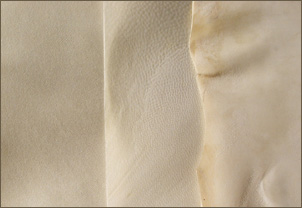Animal skin (usually calf, sheep or goat) was transformed into
a suitable writing surface by the parchmenter. Parchment
preparation was slow and arduous. Skins with the fewest flaws
(due to ticks, injuries, etc.) were soaked in vats filled with
a solution of lime and water from 3 to 10 days, and were stirred
several times a day. The skins would then be removed and draped,
hair side out, over a curved wooden board. The parchmenter
would then scrape off the hair and outer film with a curved blade.
It was then rinsed for two more days in fresh water to get rid
of all the lime. The wet skin would then be stretched on a wooden
frame and kept wet by ladling scoops of hot water over it. Then
a lunellum, a crescent shaped knife, would be used to
scrape the skin down. The skin was then allowed to dry on the
frame, becoming shrunken and more taut. When dry it was scraped
again until it became quite thin and the shiny surface was removed.
The
full skin would then be cut into a  number
of double leaves, or bifolia. The leaves were then gathered
into a quire of anywhere from 4 to 24 leaves, depending
upon the thickness of the parchment used, then ruled with drypoint
(blind lines scored with a stylus or back of a knife) or ink to
calibrate the writing surface.
number
of double leaves, or bifolia. The leaves were then gathered
into a quire of anywhere from 4 to 24 leaves, depending
upon the thickness of the parchment used, then ruled with drypoint
(blind lines scored with a stylus or back of a knife) or ink to
calibrate the writing surface.
The parchment
would be been rubbed with pumice or chalk before the writing in
order to decrease its oiliness and absorbency.



 number
of double leaves, or bifolia. The leaves were then gathered
into a quire of anywhere from 4 to 24 leaves, depending
upon the thickness of the parchment used, then ruled with drypoint
(blind lines scored with a stylus or back of a knife) or ink to
calibrate the writing surface.
number
of double leaves, or bifolia. The leaves were then gathered
into a quire of anywhere from 4 to 24 leaves, depending
upon the thickness of the parchment used, then ruled with drypoint
(blind lines scored with a stylus or back of a knife) or ink to
calibrate the writing surface.